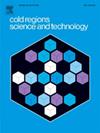Study on the cooling effect of crushed rock-based embankment of high-grade highway in permafrost region under the influence of crushed-rock fragmentation and weathering
IF 3.8
2区 工程技术
Q1 ENGINEERING, CIVIL
引用次数: 0
Abstract
In road construction within permafrost regions, the crushed rock-based embankments(CRBEs) are commonly used as active cooling measures, particularly on the Qinghai-Tibet Plateau. The unique climatic conditions in this region can lead to fragmentation and weathering of the crushed-rock within these embankments, subsequently diminishing their cooling effectiveness. This study, drawing on field observations from the Gonghe-Yushu high-grade highway(GYHH) and supplemented by numerical simulations, investigates how such degradation affects the embankment's cooling performance. Results indicate that fragmentation and weathering increase soil temperatures underneath the CRBE, accelerate the degradation rate of the permafrost table, and significantly reduce the radius and area of the frozen zone. Additionally, the permafrost table descends more slowly on shady slopes compared to sunny ones. Consequently, the altered pore structure and reduced ventilation due to rock degradation impede internal heat dissipation within the CRBE, thus undermining its cooling capacity.
多年冻土区高等级公路碎石路基在破碎破碎和风化作用下的降温效果研究
在多年冻土区的道路建设中,碎石路基(CRBEs)通常被用作主动冷却措施,特别是在青藏高原。该地区独特的气候条件可能导致这些堤坝内的碎石碎裂和风化,随后降低了它们的冷却效果。本研究以共和-玉树高等级公路(GYHH)的现场观测为基础,辅以数值模拟,探讨了这种退化对路堤冷却性能的影响。结果表明:破碎化和风化作用增加了冻土带下的土壤温度,加速了冻土带的退化速度,显著减小了冻土带的半径和面积;此外,与阳光充足的斜坡相比,背阴斜坡的永久冻土下降速度更慢。因此,孔隙结构的改变和岩石降解导致的通风减少阻碍了CRBE内部的散热,从而削弱了其冷却能力。
本文章由计算机程序翻译,如有差异,请以英文原文为准。
求助全文
约1分钟内获得全文
求助全文
来源期刊

Cold Regions Science and Technology
工程技术-地球科学综合
CiteScore
7.40
自引率
12.20%
发文量
209
审稿时长
4.9 months
期刊介绍:
Cold Regions Science and Technology is an international journal dealing with the science and technical problems of cold environments in both the polar regions and more temperate locations. It includes fundamental aspects of cryospheric sciences which have applications for cold regions problems as well as engineering topics which relate to the cryosphere.
Emphasis is given to applied science with broad coverage of the physical and mechanical aspects of ice (including glaciers and sea ice), snow and snow avalanches, ice-water systems, ice-bonded soils and permafrost.
Relevant aspects of Earth science, materials science, offshore and river ice engineering are also of primary interest. These include icing of ships and structures as well as trafficability in cold environments. Technological advances for cold regions in research, development, and engineering practice are relevant to the journal. Theoretical papers must include a detailed discussion of the potential application of the theory to address cold regions problems. The journal serves a wide range of specialists, providing a medium for interdisciplinary communication and a convenient source of reference.
 求助内容:
求助内容: 应助结果提醒方式:
应助结果提醒方式:


